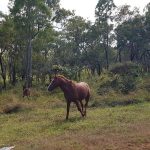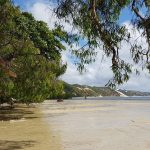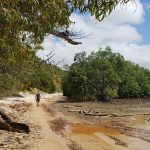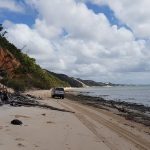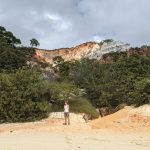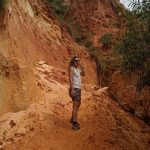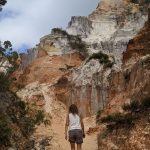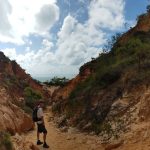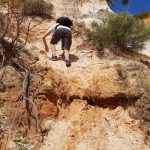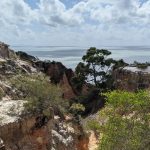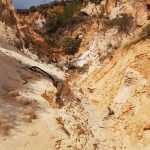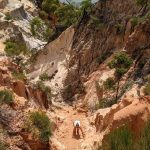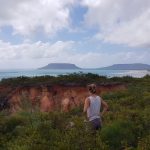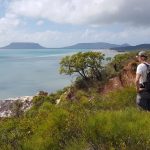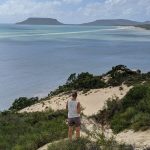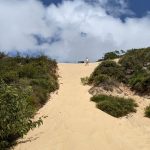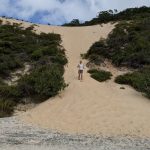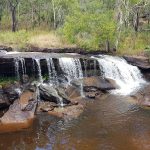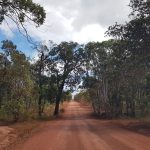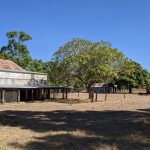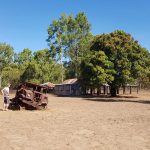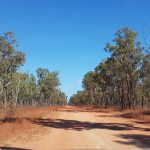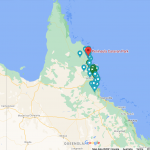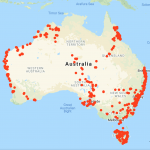Saturday 31st July 2021
Time to do a little touring here at Cooktown. We have had a couple of quiet days and it is our last full day here, so time for a bit exploring.
First stop, the coloured sands of Elim Beach, near Hope Vale Aboriginal community, It was a beautiful walk along the beach in the shallows of the low tide, passed amazing paperbark trees, mangroves and then along the squeaky white sand as the coloured sands emerges from the coastline with vibrant red and white cliffs. We arrived at the section where it is possible to climb to the top of the cliffs, some of it so steep you are on your hands and knees, digging your hands in perpendicular to the ground up to your wrists to hold you steady as you climb the difficult sandy face to the top. Even David was on his hands and knees and was surprised how hot and tough it was. The coloured sands were so spectacular, the changing colours of white, red, pink and orange against the blue water and sky, as well as the vibrant green of the bushes. We then bush bashed across the top to the sand section where we ran down the steep slope. We would have loved to slide down on some cardboard, it really would have been a hoot!
Then we headed to Isabella Falls which was okay but nowhere near as spectacular as we have become accustomed to. Next stop was Lake Emma, then Old Laura Homestead is in the southern part of Rinyirru (Lakefield) National Park.
We then finished the loop and headed home for a swim at the Cooktown outdoor pool. It was a very hot and dry day with a temperature of 30°C. We have now travelled just over 8000km. Woohoo us!!
“Fergus O’Beirne, a young Irish immigrant who bought the Laura Station lease (12,800ha) in 1879 for just over £8. By 1894 he had over 8000 head of cattle—the success due largely to the contribution of the Aboriginal workers.
When Patrick Bernard and David Grogan took over the lease in 1925, they improved and added to the homestead and outbuildings. The Lakefield Cattle Company purchased the Laura and Lakefield properties in 1966, but abandoned Old Laura Homestead in favour of New Laura, 24km north. The homestead fell into disrepair.
In 1978, the Queensland Government purchased both stations and volunteers restored the homestead and the outbuildings, which are now recognised on the Queensland Heritage Register.”
- As we drove towards the Aboriginal Community of Hope Vale we saw many wild brumbies..
- ..Our first glimpse of the silica white sands of Elim Beach..
- ..as we head towards the beach this is the first view of the water and white sand..
- ..after paying to walk to the coloured sand (only $10) we walked along the beach, if you drive they tell you to hug the trees as the sand can be like quicksand in laces..
- ..it was a lovely walk, you can see the coloured sand in the distance..
- ..the paperbark trees were spectacular..
- ..and then passed the mangroves (minus the crocs 🙁 to DBs disappointment)..
- ..a car hugging the cliffs..
- ..and we make it to the beautiful colourful sands, can we make it to the top..
- ..as we head in to the cliffs, the colour is amazing..
- ..and ever changing..
- ..as we start the uphill on our feet..
- ..then on to our hands and knees..
- ..see David just up near the bushes on the left, almost to the top..
- ..looking back down to the beach..
- ..David at the last stage..
- ..now it is my turn on my hands and knees..
- ..as I continue up and up..
- ..made it almost to the top..
- ..looking out to Cape Bedford (the flat top hill on the left in the distance)
- David at the top..
- ..and I made it as well..
- The sand dune we get to run down..
- ..and here I go, it is sooo steep….
- ..almost there.
- ..walking back to the car..
- View of the coloured sands from the camping ground.
- More wild brumbies as we head away from Hope Vale..
- Isabella Falls..
- As we continue on our drive the sand is so red..
- ..we come to a river crossing..
- ..then arrive at the Old Laura Homestead..
- .David said “Don’t think i can get that one going”, maybe an understatement..
- ..as we continue the sand changes colour..
- ..and we see a little snake on the road as well, a little dead but still a warning to us..
- ..bales and bales of feed with the Great Dividing Range in the distance..
- Today’s travels 358km
- Where we are currently at the red arrow, 2734km and 30 hours from home, without any side tracks..
- We are adding more red dots to where we have been in Australia. We shall add a few more before we get home again. Take care and stay safe everyone.
